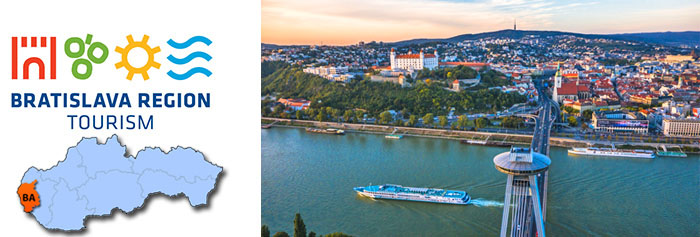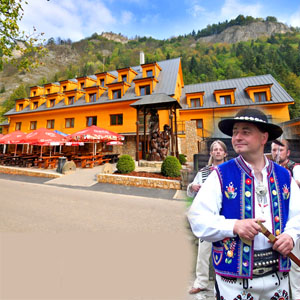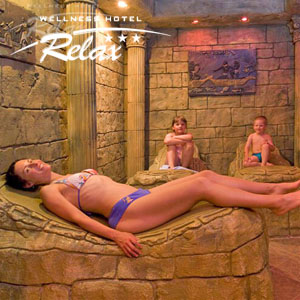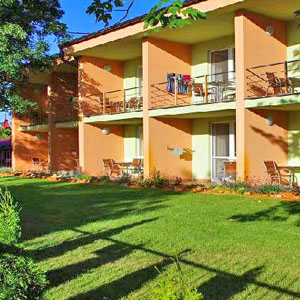Bratislava Self-Governing region
Address

Bratislava Region Tourism
Sabinovská ul. 16, Bratislava 25
S l o v a k i a
tel.: +421 2 431 91 692
www.tourismbratislava.com
info@tourismbratislava.com
www.facebook.com/BratislavaRegionTourism
- General information about the region
- Tourist attractions of the city of BRATISLAVA
- Tourist attractions of the BRATISLAVA REGION
- Bratislava City Card
General information about the region
Location
The Bratislava Self-Governing Region is, with its territory of 2053 km², the smallest self-governing region in Slovakia. It is located in the western part of Southeastern Slovakia, at the river Danube, at the frontier of large natural units (the Carpathians, the Alps, Vienna and Danube basin). From economical point of view, this erritory lies in the so called „golden triangle“ – near the triple border of Slovakia, Austria and Hungary, close enough to the Czech borders and large cities as Vienna, Győr, Budapest, Brno. Economically, it belongs to the most important regions of Slovakia – more than one quarter of the whole Slovak GDP is generated here.
History
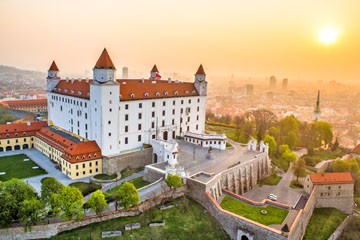 The strategic importance of its location is proven by the establishment of numerous ancient military camps protecting commercial roads as well as the borders of the Roman Empire along the middle course of river Danube – Limes Romanus (Rusovce, Bratislava, Devín). However, the economic development was influenced most by the location at the crossroads of historical commercial roads – Trans- Danubian road (it connects Western and Eastern Europe) and the Amber Road (an ancient business road of expensive amber and other precious commodities connecting Northern and Southern Europe – from the Baltic Sea to the Adriatic).
The strategic importance of its location is proven by the establishment of numerous ancient military camps protecting commercial roads as well as the borders of the Roman Empire along the middle course of river Danube – Limes Romanus (Rusovce, Bratislava, Devín). However, the economic development was influenced most by the location at the crossroads of historical commercial roads – Trans- Danubian road (it connects Western and Eastern Europe) and the Amber Road (an ancient business road of expensive amber and other precious commodities connecting Northern and Southern Europe – from the Baltic Sea to the Adriatic).
Another important phase in the development of this region was the first historical state formation in this territory – The Great Moravian Empire (833–907 A.D.) with relatively dense settlements, particularly in the Záhorie and Danubeland.
Precious sacral relics have been preserved from these times (Basilica on the Bratislava Castle, churches on Devín). The arrival of the ancient Huns (since 896) resulted in the ultimate downfall of the Great Moravian Empire and the territory became part of Ugria for the following millennium (1001–1918). Bratislava became an important border business and administration centre; in 1291 it gained the status of a free royal city. After the disastrous defeat of the Ugrian troops and subsequent occupation of Buda by the Turks, Bratislava temporarily became the capital of Ugria (1536–1848); in the period between the years 1563–1830 it was also a coronation city.
Present times
Today, the territory of the Bratislava Self-Governing Region is a dynamically developing area with a number of functions. Its absolute centre is the city of Bratislava – the capital of the Slovak Republic, the seat of the most important political, cultural, economic and social institutions. It is the only capital to have borders with two states (with Hungary in the south and Austria in the west).
Tourist attractions of the city of BRATISLAVA

Bratislava Castle – today the dominant of the city rising above the river Danube serves the needs of the state representation, its premises host the expositions of the Slovak National Museum.
Historical, cultural and sacral relics
Primatial Palace (1778–1781) with its facade in classicistic style, it was built instead of the original palace that belonged to the Archbishop of Esztergom. It is decorated with the cardinal crest of Jozef Batthyányi, (the first inhabitant of the palace) and an iron model of his hat. The oldest public well of the city – the fountain of St. George – is situated in the inner courtyard of the palace. He was a legendary knight who protected virgin Dúbravka from the dragon (the dragon is a symbol of the fight of the Catholic Church against the reformation).
 Old Town hall – originally a tithing house from the 13th century with annexes and a Gothic chapel of St. Luis decorated by paintings from the 15th century, it fulfilled the function of a town hall already in the 15th century. Today, the Museum of the City of Bratislava is located here (established in 1868); its renaissance courtyard is used for cultural events. The pride of the city in front of the Old Town hall is the Roland’s fountain built in 1572 that keeps the story of the mystic hero, knight Roland – the defender of the city, who, according to the legend, once in a year – precisely on New Year’s Eve – comes to life, though, can only be seen by natural-born Bratislava citizens with a clear sinless heart.
Old Town hall – originally a tithing house from the 13th century with annexes and a Gothic chapel of St. Luis decorated by paintings from the 15th century, it fulfilled the function of a town hall already in the 15th century. Today, the Museum of the City of Bratislava is located here (established in 1868); its renaissance courtyard is used for cultural events. The pride of the city in front of the Old Town hall is the Roland’s fountain built in 1572 that keeps the story of the mystic hero, knight Roland – the defender of the city, who, according to the legend, once in a year – precisely on New Year’s Eve – comes to life, though, can only be seen by natural-born Bratislava citizens with a clear sinless heart.
 Michalská gate – originally a Gothic tower with an onion-shaped roof, it comes from the 14th century. In the period between the years 1753–1758 it went through a baroque reconstruction. From the upper terrace of the tower there is a spectacular view on the historical centre of the city. The top of the tower is decorated by a copper statue of Archangel Michael fighting with a dragon, under the tower there is the so-called zero kilometre depicting the distances of 29 metropolis cities from Bratislava. Next to the Michalská gate is the narrowest house of the city, its facade is only 130 cm wide.
Michalská gate – originally a Gothic tower with an onion-shaped roof, it comes from the 14th century. In the period between the years 1753–1758 it went through a baroque reconstruction. From the upper terrace of the tower there is a spectacular view on the historical centre of the city. The top of the tower is decorated by a copper statue of Archangel Michael fighting with a dragon, under the tower there is the so-called zero kilometre depicting the distances of 29 metropolis cities from Bratislava. Next to the Michalská gate is the narrowest house of the city, its facade is only 130 cm wide.
 Grassalkovich palace – this rococo style building was built for the advisor of Empress Mary Theresa, Mr. Anton Grassalkovich in 1760 and it became the centre of social life of the local aristocracy. Today, it serves as the seat of the President (not accessible to public). The palace has a nice – and public – park with the statue of Mary Theresa, the fountain of Youth, other statues created by modern artists and the Alley of Presidents (the visiting heads of states traditionally plant a small oak tree here).
Grassalkovich palace – this rococo style building was built for the advisor of Empress Mary Theresa, Mr. Anton Grassalkovich in 1760 and it became the centre of social life of the local aristocracy. Today, it serves as the seat of the President (not accessible to public). The palace has a nice – and public – park with the statue of Mary Theresa, the fountain of Youth, other statues created by modern artists and the Alley of Presidents (the visiting heads of states traditionally plant a small oak tree here).
Universitatis Istropolitana (Academia Istropolitana) – the first university on the territory of present Slovakia; it was founded during the Ugrian renaissance by king Matthias Corvinus in 1467. It provided education in the field of humanistic, theological and natural sciences in four faculties. Today, this beautiful building serves the students of High School of Music and Art.
Slovak National Theatre – this historical building in eclectic style was opened in 1887. It is the masterpiece of architects Ferdinand Fellner and Hermann Helmer – a successful couple, who made the projects of other theatres, too, e.g. in Sofia, Budapest, Brno, Karlové Vary, Zürich, Berlin and other European cities.
 St. Martin’s Cathedral – the construction of this Gothic church (built in the place of the original Roman church) began in the 13th century, gaining its current form in 1849. It has 4 chapels and it’s also the coronation place of Mary Theresa.
St. Martin’s Cathedral – the construction of this Gothic church (built in the place of the original Roman church) began in the 13th century, gaining its current form in 1849. It has 4 chapels and it’s also the coronation place of Mary Theresa.
„Blue church“ – the St. Elisabeth Church – this building of Bratislava, beautiful as a fairy tale, was built in Art Nouveau style with a cylindrical tower and unconventional light blue colour. Elisabeth, patroness of the poor and the sick, was the daughter of the Hungarian King Andrew II. from the Arpad family.
Dominants of the modern times from the era
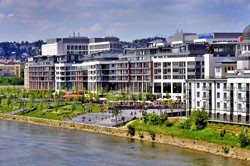 Of the socialist regime The building of the Slovak radio will attract one’s eye with its shape of a reverse pyramid The New bridge with a scenic restaurant in UFO-shape sitting on a pillar 85 m high (it´s one of the ten largest suspension bridges in the world) Slavín – national cultural memory, a monumental memorial and the only military cemetery of the soldiers of the Soviet army in Bratislava still working, with a wonderful view on the surroundings.
Of the socialist regime The building of the Slovak radio will attract one’s eye with its shape of a reverse pyramid The New bridge with a scenic restaurant in UFO-shape sitting on a pillar 85 m high (it´s one of the ten largest suspension bridges in the world) Slavín – national cultural memory, a monumental memorial and the only military cemetery of the soldiers of the Soviet army in Bratislava still working, with a wonderful view on the surroundings.
Post-modern urbanism – new challenges and trends of the city architecture of the 21st century
Eurovea complex – a new city quarter, polyfunctional centre containing a shopping and entertainment centre, a complex of flats, administration centre, luxury hotel under one roof with pertaining promenade on the bank of river Danube.
River park – another multifunctional complex at the waterfront, it contains residential flats, a luxury hotel with wellness, office premises, commercial and financial services, leisure time activities.
Museum of Modern Art Danubiana was built in attractive location next to the river Danube, in Čunovo.
Pieces of interest
The sightseeing of the historical centre of the city will be made even more pleasant by an unconventional companionship – curious statues of various characters – e.g. Čumil – happily smiling from a sewer, Schöne Naci – an eternal heartbroken gentleman, an admirer of the gentle sex (a memory of the local wretch who was disappointed in love), Napoleónec leaning against a bench on the Main Square, Paparazzi waiting for the local celebrities in front of the restaurant with the same name. The city offers its visitors numerous opportunities for spending their leisure time, cultural and sport events, gastronomy enjoyments and a wide palette of accommodation facilities starting with cheap hostels and ending with the most luxurious hotels, while at the same time it provides very good conditions for congress or incentive tourism, too.
Tourist attractions of the BRATISLAVA REGION
Historical, cultural and sacral relics
 Devin Castle – it stands on a huge cliff above the confluence of the rivers Danube and Morava. According to the preserved documents, it is the oldest castle in Slovakia (the first written reference comes from 864). At present, the upper part is closed, its other parts are accessible and various expositions are taking place in the premises of the castle.
Devin Castle – it stands on a huge cliff above the confluence of the rivers Danube and Morava. According to the preserved documents, it is the oldest castle in Slovakia (the first written reference comes from 864). At present, the upper part is closed, its other parts are accessible and various expositions are taking place in the premises of the castle.
 The Red Rock Castle (Častá) – Renaissance fortress, originally a royal castle with a history dating back to the 13th century and having the largest underground premises, the oldest pharmacy and the largest collection of historical furniture. Today, it serves as a museum. Thanks to its preserved interiors and fascinating exteriors, various social events take place here, also movies and fairy-tales were shot here.
The Red Rock Castle (Častá) – Renaissance fortress, originally a royal castle with a history dating back to the 13th century and having the largest underground premises, the oldest pharmacy and the largest collection of historical furniture. Today, it serves as a museum. Thanks to its preserved interiors and fascinating exteriors, various social events take place here, also movies and fairy-tales were shot here.
Gerulata – relics of a Roman military camp in Bratislava-Rusovce from the period of the 1st– 4th century A.D. – exposition of stone building ruins, gravestones and items of everyday use by Roman soldiers.
 Ruins of Plavecky castle (Plavecké Podhradie) – ruins of the royal castle dating back to the 13th century and the ruins of Pajstun Castle –(at the village of Borinka), also from the 13th century, destroyed during the Napoleon wars.
Ruins of Plavecky castle (Plavecké Podhradie) – ruins of the royal castle dating back to the 13th century and the ruins of Pajstun Castle –(at the village of Borinka), also from the 13th century, destroyed during the Napoleon wars.
The Church of Assumption of Virgin Mary (Boldog), originally built in the 13th century in Roman style, later reconstructed in Baroque style; preserves the oldest written memory of Slovakia – a limestone board with Latin inscription from the gravestone of a Roman soldier – trader (year 70–138 A.D.)
Unique buildings of the Habans (Veľké Leváre) – remnants of folk architecture of immigrants from Switzerland from the period of the 17th–19th century. Today it is a museum with a beautiful collection of Haban potery (so-called faience).
Country tourism – gastronomy enjoyments and local folklore
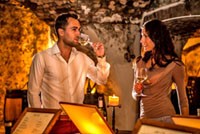 Small Carpathian wine road – embracing Bratislava, Svätý Jur, Pezinok, Modra and other distinctive Small Carpathian towns that keep the tradition of local wine-making, gastronomy specialties and folklore. In Pezinok, there is the Small Carpathian Museum with the history of the local viticulture and wine-making.
Small Carpathian wine road – embracing Bratislava, Svätý Jur, Pezinok, Modra and other distinctive Small Carpathian towns that keep the tradition of local wine-making, gastronomy specialties and folklore. In Pezinok, there is the Small Carpathian Museum with the history of the local viticulture and wine-making.
The village of Slovenský Grob offers traditional goose specialties, the Modra majolica is also well-known. Every year various programmes and festivals are organized here (Days of open cellars, Vintage days, Wine markets).
Bee Museum (Kráľová pri Senci) – the largest bee open-air museum in Middle Europe.
Natural attractions
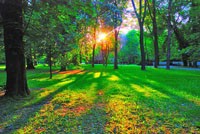 National Natural Reserve – Devínska Kobyla- Sandberg trail – this hill is a spur of the Small Carpathians above the river Morava before its confluence with the Danube. One can find here rare and endangered species of plants. It’s also a paleontologically important site of Cenozoic fossils. Trail of the Morava floodplain – the longest educational trail in Slovakia, its length is 79 km.
National Natural Reserve – Devínska Kobyla- Sandberg trail – this hill is a spur of the Small Carpathians above the river Morava before its confluence with the Danube. One can find here rare and endangered species of plants. It’s also a paleontologically important site of Cenozoic fossils. Trail of the Morava floodplain – the longest educational trail in Slovakia, its length is 79 km.
Protected landscape area Dunajské luhy – a territory with a river branch system and associated wetlands of the Danube, rare species of flora and fauna typical for this region are found here. This site is a refuge of protected waterfowl. National Natural Reserve Šúr (Svätý Jur, Chorvátsky Grob) – a site listed as a wetland of international importance with protected species of plants and animals, part of it is accessible by a trail.
Recreational and sports tourism
 Sunny lakes (next to Senec) – the most popular resort of summer tourism, the centre with complementary equipment – one can find here hotels as well as an indoor aqua park, various programmes and festivals are organized here.
Sunny lakes (next to Senec) – the most popular resort of summer tourism, the centre with complementary equipment – one can find here hotels as well as an indoor aqua park, various programmes and festivals are organized here.
Area of water sports in Čunovo – rafting on Hrušov water dam, the area of water sports meets the requirements of world-level stadiums.
International Danube cycling route – its section in Slovakia begins in Petržalka, it leads to Čunovo and to port bridge, along the left bank of Danube across Šamorín – Gabčíkovo up to Štúrovo.
Golf clubs and playgrounds – in Bratislava (a number), Lozorno, Záhorská Bystrica, Bernolákovo, Malacky.
Bratislava City Card
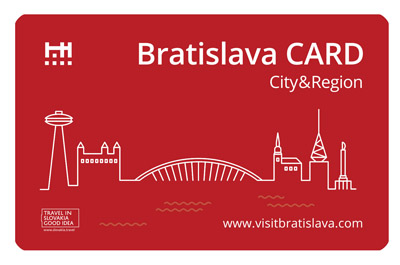 The official tourist destination card helping you get to know the best of Bratislava.
The official tourist destination card helping you get to know the best of Bratislava.
The Bratislava CARD is the official tourist destination card helping you get to know and experience the best that Bratislava and the Bratislava Region have to offer.
Important notice
due to current COVID-19 situation and strict measures taken by local authorities, we are forced to stop the sale of the Bratislava CARD at all sales points, as well as an online sale, immediately from October 24, 2020 until further notice.
- Hotel MAJOLIKA, Modra
- Vila Thoma, Modra
- Hotel SET, Bratislava
- Pension Pálenica, Bernolákovo
- KAMENNY MLYN - Hotel ROZALIA, Plavecky Stvrtok
- Residence HARLEQUIN, Bratislava
- Bungalows SCR Senec, Senec
- JURKI Dom Hotel, Bratislava
- VILLA SIPEKY, Senec
- APARTMENT RESIDENCE, Bratislava
View all Accommodation Bratislava and surroundings
- ROLAND RESTAURANT & CAFE , Bratislava
- CAFE restaurant SLIMACKA, Pezinok
- HUSACINA U ZAPRAZNYCH , Slovensky Grob
- Restauracia OLYMPIA, Bratislava
- Restaurant Hotel MAX INN, Bratislava
- Hotel PRESIDENT - Kaviareň, Bratislava
- Restaurant Strkovec - Hotel Junior***, Bratislava
- KAMENNY MLYN - Hotel ROZALIA, Plavecky Stvrtok
- Restaurant Hotel Antares, Bratislava
- Restauracia PORTUS, Bratislava
View all Restaurants Bratislava and surroundings
- Congress centre INCHEBA €XPO ARENA, Bratislava
- Training rooms - Hotel SENEC, Senec
- HOLIDAY VILLAGE, Senec
- Mountain hotel EVA, Svaty Jur
- Hotel ZATOKA, Senec
- Congress & Biznis Hotel SOREA Regia, Bratislava
- Congress and Business Hotel TATRA, Bratislava
- Arkady Hof Hotel, Stupava
- Hotel WEST, Bratislava
- Hotel Dolphin, Senec
View all Congresses Bratislava and surroundings
- Viva Musica!, Bratislava
- Kart One Arena, Bratislava
- PEZINOK CASTLE, Pezinok
- Saint Vit's Church Rusovce, Bratislava
- Darkona Horseback Riding Area, Bratislava
- GRASSALKOVICH PALACE, Bratislava
- Danubiana - Meulensteen Art Museum, Bratislava
- Nipponfest a Hangukon - Ázijské kultúrne festivaly, Bratislava
- Beer Festival Pezinok Pije Pivo 2018, Pezinok
- SKI RESORT Pezinská Baba, Pezinok
View all Attractions Bratislava and surroundings







